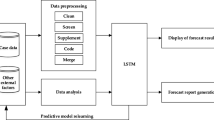Abstract
The Corona Virus Disease 2019 (COVID-19) has widely spread over the world and comes up with new challenges to the research community. Accurately predicting the number of new infections is essential for optimizing available resources and slowing the progression of such diseases. Long short-term memory network (LSTM) is a typical method for COVID-19 prediction in deep learning, but it is difficult to extract potentially important features in time series effectively. Thus, we proposed a Bidirectional LSTM (BiLSTM) model based on the attention mechanism (ATT) and used the Sparrow Search Algorithm (SSA) for parameter tuning, to predict the daily new cases of COVID-19. We capture the information in the past and future through the BiLSTM network and apply the attention mechanism to assign different weights to the hidden state of BiLSTM, enhance the ability of the model to learn vital information, and use the SSA to optimize the critical parameters of the model for matching the characteristics of COVID-19 data, enhance the interpretability of the model parameters. This study is based on daily confirmed cases collected from six countries: Egypt, Ireland, Iran, Japan, Russia, and the UK. The experimental results show that our proposed model has the best predictive performance among all the comparison models.
Supported by National Natural Science Foundation of China (No. 61572090), Chongqing Science and Technology Project (No. cstc2018jscx-mszdX0109), and the Fundamental Research Funds for the Central Universities (No. 2020CDJYGRH-YJ04).
Access this chapter
Tax calculation will be finalised at checkout
Purchases are for personal use only
Similar content being viewed by others
References
Kermack, W.O., Mckendrick, A.G.A.: A contribution to the mathematical theory of epidemics. Proc. R. Soc. Math. Phys. Eng. Sci. 115(772), 700–721 (1927)
Hernandez-Matamoros, A., Fujita, H., Hayashi, T., Perez-Meana, H.: Forecasting of COVID19 per regions using ARIMA models and polynomial functions. Appl. Soft Comput. 96, 106610 (2020)
Schuster, M., Paliwal, K.K.: Bidirectional recurrent neural networks. IEEE Trans. Sig. Process. 45(11), 2673–2681 (1997)
Du, S., et al.: Predicting COVID-19 using hybrid AI model. IEEE Trans. Cybern. 50(7), 2891–2904 (2020)
Zhu, X., et al.: Attention-based recurrent neural network for influenza epidemic prediction. BMC Bioinform. 20(Suppl. 18), 575 (2019)
Xue, J., Shen, B.: A novel swarm intelligence optimization approach: sparrow search algorithm. Syst. Sci. Control Eng. 8(1), 22–34 (2020). https://doi.org/10.1080/21642583.2019.1708830
Elsheikh, A.H., Saba, A.I., Elaziz, M.A., Lu, S., Shehabeldeen, T.A.: Deep learning-based forecasting model for COVID-19 outbreak in Saudi Arabia. Process Saf. Environ. Prot. 149, 223–233 (2021)
Martínez-lvarez, F., et al.: Coronavirus optimization algorithm: a bioinspired metaheuristic based on the COVID-19 propagation model. Big Data 8(4), 308–322 (2020)
Hu, J., Zheng, W.: A deep learning model to effectively capture mutation information in multivariate time series prediction. Knowl.-Based Syst. 203, 106139 (2020)
Lipton, Z.C., Berkowitz, J., Elkan, C.: A critical review of recurrent neural networks for sequence learning. In: Computer Science (2015)
Wang, S., Wang, X., Wang, S., Wang, D.: Bi-directional long short-term memory method based on attention mechanism and rolling update for short-term load forecasting. Int. J. Electr. Power Energy Syst. 109, 470–479 (2019). https://doi.org/10.1016/j.ijepes.2019.02.022
Xu, K., et al.: Show, attend and tell: neural image caption generation with visual attention. In: Computer Science, pp. 2048–2057 (2015)
Johns Hopkins University: Center for systems science and engineering. https://github.com/CSSEGISandData/COVID-19. Accessed 2 Mar 2021
Rumelhart, D., Hinton, G.E., Williams, R.J.: Learning representations by back propagating errors. Nature 323(6088), 533–536 (1986)
Lerman, P.M.: Fitting segmented regression models by grid search. J. R. Stat. Soc. Ser. C (Appl. Stat.) 29(1), 77–84 (1980). http://www.jstor.org/stable/2346413
Author information
Authors and Affiliations
Corresponding author
Editor information
Editors and Affiliations
Rights and permissions
Copyright information
© 2021 Springer Nature Switzerland AG
About this paper
Cite this paper
An, S., Chen, S., Yuan, X., Yuwen, L., Mei, S. (2021). A SSA-Based Attention-BiLSTM Model for COVID-19 Prediction. In: Mantoro, T., Lee, M., Ayu, M.A., Wong, K.W., Hidayanto, A.N. (eds) Neural Information Processing. ICONIP 2021. Communications in Computer and Information Science, vol 1517. Springer, Cham. https://doi.org/10.1007/978-3-030-92310-5_14
Download citation
DOI: https://doi.org/10.1007/978-3-030-92310-5_14
Published:
Publisher Name: Springer, Cham
Print ISBN: 978-3-030-92309-9
Online ISBN: 978-3-030-92310-5
eBook Packages: Computer ScienceComputer Science (R0)




